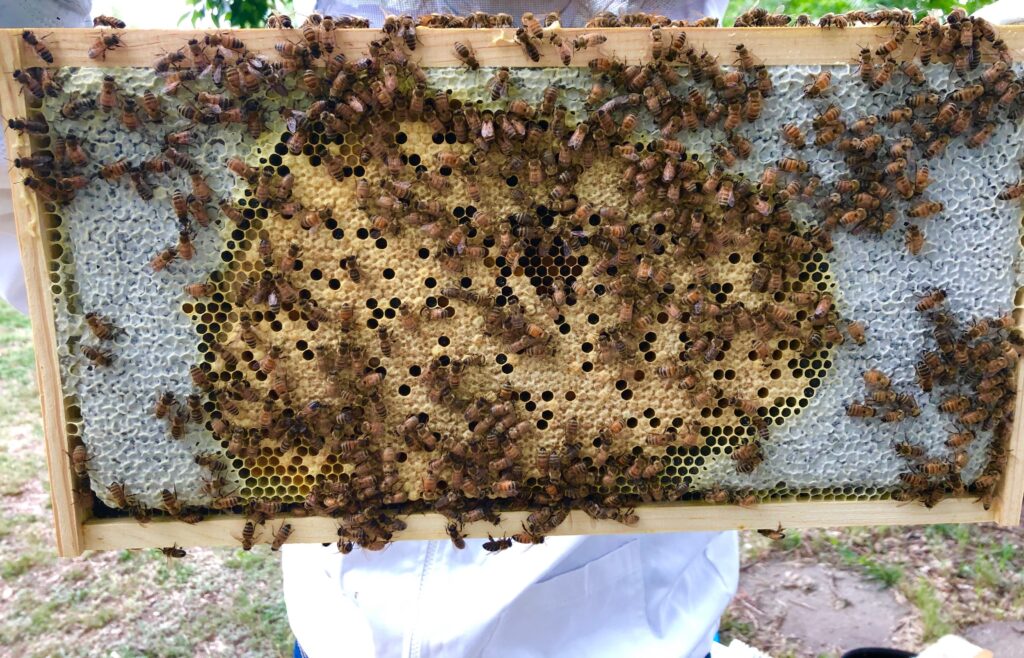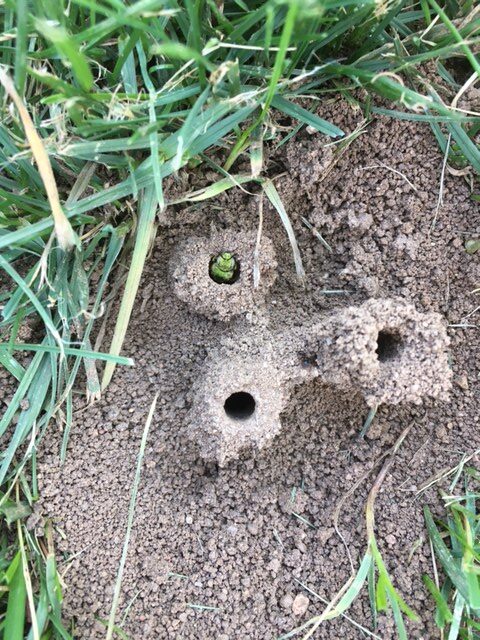From the Hort Desk
- 2023-01-05
- By mkirk
- Posted in Horticulture, The Garden Buzz
By Lisa Mason, CSU Horticulture Agent
Where Do Bees Go in the Winter?
I have been asked a few times this season what happens to the bees in the winter. Bees and other insects have special adaptations so their species survives from year to year. Here is a look at bee adaptations and life cycles in the wintertime.
Honey bees
Worker bees forage all summer and into fall bringing in food reserves to last them the winter. When temperatures start to drop, honey bees huddle together to make a cluster and shiver their wings. Shivering provides warmth for the hive. Their main goal is to keep the queen warm so the colony can survive. The core temperature in the hive can be as high as approximately 91°F. A healthy hive with adequate food storage is more likely to survive, which reinforces the importance of best beekeeping practices by the beekeeper all year. Read how to prep a hive for winter here. When beekeepers harvest honey, they have to be careful not to harvest too much. Beekeepers should leave 80-100 pounds of honey in the hive for the bees to feed on throughout the winter. Honey bees are often seen outside the hive on warm winter days. Any time temperatures rise above 55°F, honey bees may take a cleansing flight which provides them the opportunity to relieve themselves. Honey bees may also forage for whatever they can find, including tiny bits of protein at bird feeders.

Solitary bees
Solitary bees live a one-year life cycle. During the life cycle, a female bee builds a nest underground or in a cavity. A cavity usually consists of a pre-existing tunnel. Some tunnels might be in a dead log, nooks and crannies in stone or brick, a human-made bee hotel, or hollow stems. The female bees collect pollen and nectar to bring back to the nest. All the collected pollen and nectar is made into a ball called “bee bread,” which is all the food needed for one bee to grow from a larva to an adult. The female lays an egg on the bee bread and seals up the nest. After the egg hatches, the larva will go through full metamorphosis from a larva, to a pupa, and on to an adult before emerging from the nest the following season. The lives have ended for the female and male solitary bees we saw flying around the previous summer, but their brood is warm for the winter deep underground or in a cavity.

Bumble bees
Bumble bees live underground or in large cavities. They have a one-year life cycle, like solitary bees. They have a social structure within their colonies that includes a reproductive queen and workers. Like other social insects, they have overlapping generations and cooperative brood care in the colony. Newly mated queens are the only bumble bee survivors during the winter. The hardy queens find a place to hibernate in a protected place like leaf litter, a wood pile, or underground. When spring arrives, the queens will emerge, begin to forage, build a new nest, and lay eggs. The eggs will mostly be female worker bees at the beginning of the season. The queen will continue to lay eggs throughout the season. In late summer, new queens and male bumble bees will hatch and leave the colony to find mates. As temperatures drop, the colony from the current season will end, except for the mated queens that will hibernate. Queen bumble bees are capable of living alone, unlike honey bee queens.

Does “leaving the leaves” support the overwintering bees?
Leaf litter supports hibernating bumble bees by providing them a sheltered area for the winter. Solitary bees are well-protected in their underground or cavity nest but leaf litter may provide some insulation for their ground nest. Since honey bees live in hives, they don’t rely on leaf litter but they have been observed drinking water from damp leaf piles. Leaf litter also supports a wide diversity of arthropods by providing shelter during the winter. Wooly bear caterpillars are a great example of a moth that relies on leaf litter. They overwinter in the caterpillar stage by hibernating in leaf litter. They have impressive adaptations to survive the winter. When summer arrives, they complete metamorphosis and transform to adult Isabella tiger moths. Overall, leaf litter can provide a shelter for a diversity of overwinter arthropods. Leaf litter is also a great mulch for perennial and vegetable gardens. The leaves also return critical nutrients back to the soil. While leaf litter is a valuable component to the landscape, it is important to remove leaves from the lawn to prevent mold and disease growth, and to avoid smothering the turf.
When should spring garden clean-up begin to best support the overwintering bees?
Different bee species emerge at different times, so it is a challenge to find a perfect date for spring garden clean-up that supports bees. Here are some general considerations for supporting overwinter bees:
- Bumble bees typically emerge from hibernation between mid-April and mid-May, depending on weather and elevation. Bumble bees could be impacted if leaf litter is disturbed before they emerge.
- Some solitary bees nest in hollow or pithy stems such as Rubus spp. (raspberries, blackberries, etc.), joe-pye weed, bee balm, etc. They will emerge in the spring. If hollow stems appear to be plugged, perhaps consider leaving the stems until they emerge, or stems could be carefully moved to a protected location where they won’t be disturbed.
- Leafcutter bees are often some of the latest emerging bees. They nest in a wide variety of cavity locations from natural spaces to human infrastructure (e.g. patio stones, and occasionally even inside gardening gloves). Since they emerge later in the season, it is likely best not to postpone garden work for leafcutter bees unless specific locations of nests are known that could be protected.
- Squash bees may nest in underground areas where squash and pumpkin plants are typically planted. Consider not tilling the vegetable garden to support these important pollinators.
- All bees need early-season flowers that offer pollen and nectar. Consider adding plants that flower as early as April and May. Some options include golden currant, chokecherry, crocus, and pasque flowers.

More information
For more information on bee life cycles, check out the Native Bee Watch Citizen Science Field Guide. Learn more about the 900+ native bee species in Colorado by checking out A Beginner’s Field Guide to Identifying Bees.
For more information on what happens to other insects in the winter, refer to this CO-Horts Blog post written by Jessica Wong.
Horticulture Resources
- Garden Buzz Archives
- CSU Extension Resources
- Colorado Master Gardener Program
- Foothills to Plains Native Plant Master Program
- Native Bee Watch Community Science Program
- The Co-Hort Blog
- PlantTalk Colorado
- Soil Testing
- Plant Select
- Emerald Ash Borer
- Japanese Beetle
- Colorado State Forest Service
- Ask an Expert


